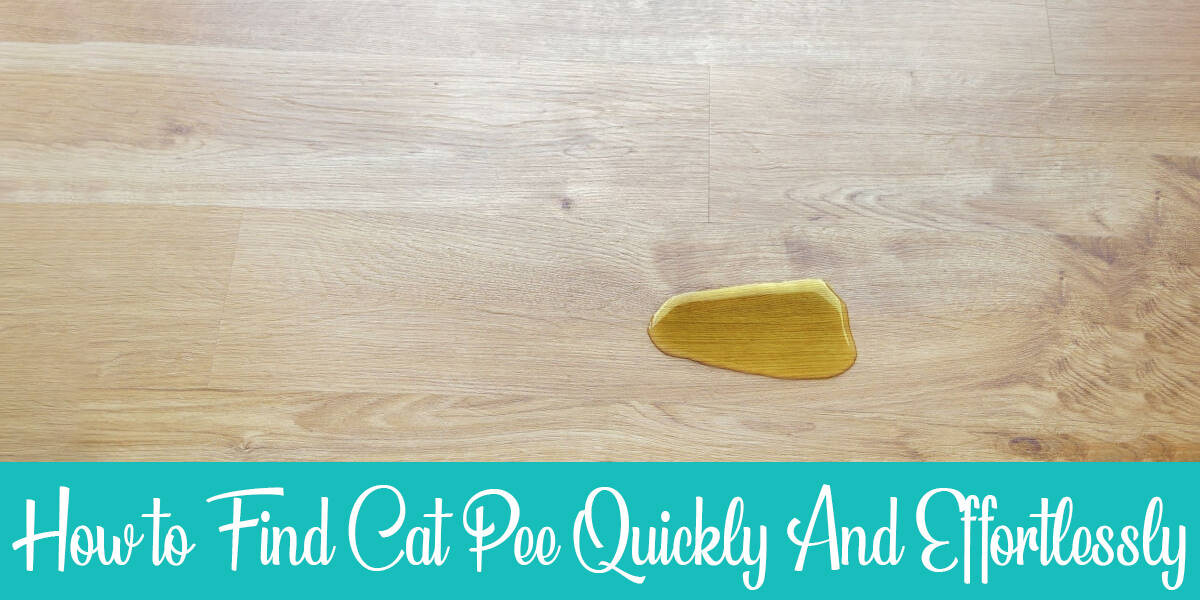‘Getting on your hands and knees to search for cat pee is fun’. Said no cat owner ever!
Every pet owner knows searching for pee stains is a nightmare. Sensing the bad smell and not knowing where it’s coming from can be extremely frustrating.
Can you do something about it? Of course! Let me show you how to find cat pee even in the hardest place.
Table of Contents
How to Find Cat Pee Using 4 Simple Methods

There are many methods to find cat pee, but not all of them are efficient. I’ll tell you how to do it with minimal effort.
Method 1 – Check the Usual Places
Cats love to pee in corners, on beddings and carpets, and on new things that smell. You ought to start with these places for an efficient search.
Sometimes, they throw random objects over their pee to hide it. You might as well search under any item that looks out of place.
You may not be able to see the stains; your smelling sense will now come in handy! Smell all the areas you suspect until you reach your goal.
Method 2 – Go for Chemistry
As Linus Pauling once said; every aspect of the world is affected by chemistry. Even your cat’s pee!
The main component in pee is ammonia. Using a little chemistry trick will expose it. Mix some peroxide with baking soda and pour it into a spraying bottle.
Spray it over the areas you’re suspecting. If an area is stained, it’ll turn white.
Method 3 – Clean Everything
Pee stains are easy to find on walls and floors. If you can’t find the stained spot, it’s probably on fabric.
It’s better to wash all the carpets and beddings. That way, you’ll be assured the place is all clean.
Method 4 – Use a Blacklight
Handheld blacklights are the easiest way to find hidden pee stains. You only need a dark room and you’re good to go. It’s better to wait until the evening so sunlight won’t compromise your mission. Additionally, turn all the light off in the room you’re searching and in the adjacent hallways.
Afterward, sweep your blacklight over all surfaces until the stain glows up.
When you turn the lights back on, you’ll not see the stain anymore. That’s why you need to mark it so you can get back to it.
Use a piece of tape or Blu Tack to mark around the stain, so its size and shape are obvious.
How to Clean Cat Pee – Quick and Easy

Getting cat pee out of fabric is a pretty easy process. You only need soapy water and enzyme cleaner, and chemistry will do the rest!
Step 1 – Pour Soapy Water Over It
Make a mix of warm water and a small amount of dish soap. Afterward, pour it over the stain and leave it for an hour.
Step 2 – Wipe It
Run a clean cloth under water and squeeze it so it’s only damp. Then wipe over the wet area. Cat pee spreads through the fabric when left for long, that’s why you should wipe beyond the edges of the stained spot.
Step 3 – Use an Enzyme Cleaner
After wiping, spray an enzyme cleaner over the area to neutralize the urine. Leave it for 20 minutes; it’ll eliminate the smell.
Make sure to read the instructions on the cleaner before you use it to make sure it suits your surface. If you want to clean a surface that shouldn’t get wet, like leather or wood, you can use a powder enzyme cleaner.
How to Stop The Cat From Spraying

Cats use urine as a way of communication. When your cat sprays, it’s either because it wants to mark its territory, or because it feels a threat coming in its way, or for different reasons.
These threats can be a new person in the house, a new cat around, or any change of routine. In order to stop your cat from this behavior, there are a few steps to take.
Step 1 – Give Your Cat Attention
You should give your cat enough attention so it doesn’t resort to spraying. If it feels abandoned, the behavior will grow worse.
Step 2 – Use Cat Spraying No More
Cat Spraying No More is a system that contains techniques to help your cat with its spraying problem. It’s a proven method that has succeeded with thousands of cats already.
Step 3 – Consult the Vet
There’s a high chance your cat is suffering anxiety if it excessively sprays around. Consult your vet to find out if the spraying is due to a medical or a psychiatric issue.
Step 4 – Don’t Let Your Cat Near Windows
Lastly, you should restrict your cat’s view of the windows and doors, where it can see other animals and be tempted to mark the territory.
Frequently Asked Questions
Conclusion
When you think your cat is getting out of control, it’s better to visit the vet. A lot of medical issues account for peeing problems, you’re going to want to steer clear of that.
Cat pee can be a hassle to deal with, especially with the effort it takes to find it. However, the clean smell afterward is totally worth it!

I’ve been living with cats since 2008 and I can confidently say I have more feline friends than humans lol. I currently live with 5 cats in different life stages; two of them are less than one year old, one is 2-ish years old and the oldest two are 9-ish years old. I’ve developed a strong bond with cats over the years and I’m eager to share my experience through this blog. You can learn more about my cats here.

